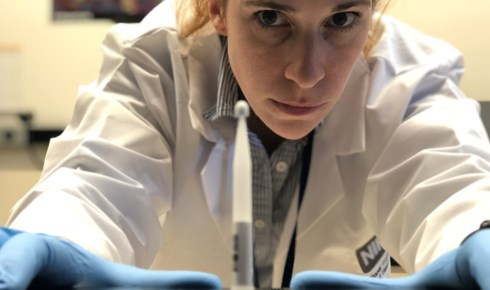"We we are calling for donors that never tested positive for SARS-CoV-2"

Immunoengineer Kaitlyn Sadtler is studying the immune response of those with little or no COVID-19 symptoms in the hope of understanding their role in the spread of the disease.
Photo courtesy of NIH/NIBIB
How has your role changed since the COVID-19 outbreak began?
I am a principle investigator at the National Institutes of Health and lead an immunology research lab. Our research generally focuses on immunology in the context of regenerative medicine and our body’s response to medical device implants. During the pandemic we are applying this immunology knowledge to detect our body’s response to coronavirus.
Can you tell us a bit about the COVID-19 related projects you are involved in?
Our laboratory is working on something called a serosurvey. In this research study, we are calling for donors that never tested positive for SARS-CoV2 to help elucidate the full extent of the spread of infection. This includes people that never had symptoms, or maybe they had the sniffles or a flu-like illness earlier this year. This is important as the asymptomatic transmission of SARS-CoV2 has been shown to be an important contributor of the spread of the disease.
Can you talk us through some of the challenges of working during these strange times, for example the adaptations required to keep yourself safe or the effect on non-COVID research projects/departmental business?
We try to keep only one or two people in the laboratory at the same time. If multiple people are in the lab, they need to be wearing masks and maintain at least a six-foot distance. We also spend extra time cleaning frequently-touched surfaces.
Our immunology work in regenerative medicine has been put on a hold for several months to ensure proper social distancing. There have been things to adapt to, including purchasing and deliveries, but the NIH has worked on how to organise the efforts going on in the COVID-19 response, including through work of the COVID-19 Special Interest Group, that I am currently on the leadership board for.
What have you noticed that you and your colleagues are doing differently owing to this being an urgent, emergency situation? Have you noticed a difference in the way teams across different fields and institutions are working?
In general, the scientific community is being very open and collaborative during this process. In our project alone, we have four different institutes from the NIH working together on our serosurvey. Multiple groups have reached out to determine how to synergise with the efforts going on in our group, and we are validating assays that will be reproducible in multiple different research locations.
How are you communicating information from your work so that it can be utilised quickly around the world?
We are communicating through the press and social media. As the data comes together, we will be sharing it through pre-print servers or similar pre-publication data sharing methods. We have been open with our protocols and plan to formally share them once our full validations have been completed.
Have you sought new funding or additional support for your work, and if so how easy was it to navigate the relevant systems to access this?
Luckily, at the NIH, if there is a valid idea that needs to be researched, we focus on it. We have not sought new funding or additional support for this work. I do not believe that doing such a project would have been easy at another institution.
Dr Kaitlyn Sadtler is Earl Stadtman Investigator and chief of immuno-engineering at the National Institute of Biomedical Imaging and Bioengineering, part of the US National Institutes of Health.


